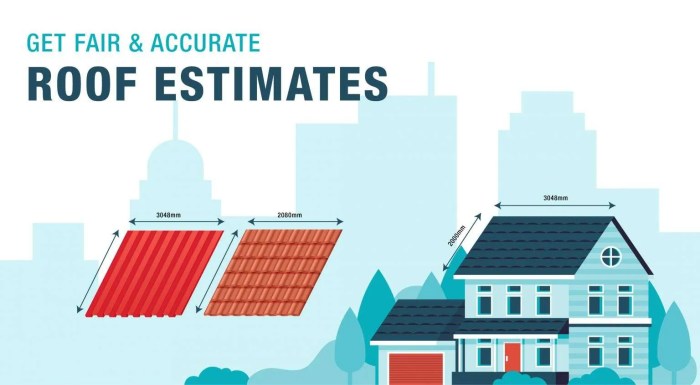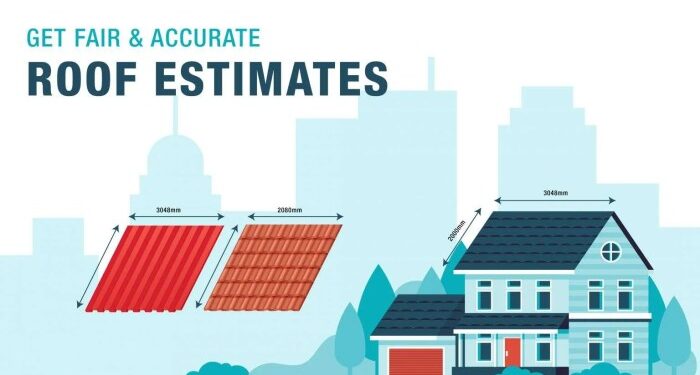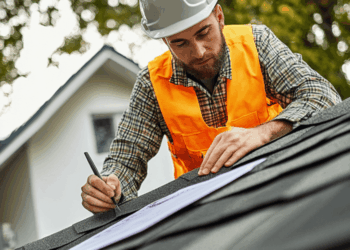Roof Estimate Guide: Calculate the True Cost of Your Roof Replacement offers valuable insights into the crucial aspects of estimating the cost of your roof replacement. Dive into this comprehensive guide that will equip you with the knowledge needed to plan and budget effectively for your roofing project.
Explore the key components, calculations, and tips that will ensure you receive an accurate roof estimate, setting you on the path towards a successful roof replacement endeavor.
Importance of Roof Estimate
Before embarking on a roof replacement project, obtaining a roof estimate is essential to ensure proper planning and budgeting. A comprehensive roof estimate provides valuable insights into the overall cost and scope of the project.
Factors Influencing Roof Replacement Cost
- Material Costs: The type of roofing material chosen significantly impacts the overall cost of the replacement. Materials such as asphalt shingles, metal, or tile vary in price.
- Roof Size and Pitch: Larger roofs require more materials and labor, leading to higher costs. The pitch of the roof can also affect the complexity of the installation, impacting the overall price.
- Roof Accessibility: The ease of access to the roof can affect labor costs. A roof that is difficult to reach or requires special equipment can increase the overall expense.
- Underlayment and Decking: The condition of the existing underlayment and decking can impact the cost. If repairs or replacements are needed, it can add to the total price.
- Labor Costs: The skill level of the roofing contractors, as well as regional labor rates, can influence the labor costs associated with the project.
Components of a Roof Estimate

When receiving a roof estimate, it is important to understand the key components that are typically included in the breakdown. This detailed breakdown helps you understand how the total cost is calculated and what factors contribute to the overall estimate.
Materials
The cost of materials is a significant portion of any roof estimate. This includes shingles, underlayment, flashing, and any other materials needed for the installation or replacement of your roof. The type and quality of materials chosen will impact the overall cost of the project.
Labor
Labor costs are another essential component of a roof estimate. This includes the cost of hiring professionals to install or replace your roof. Labor costs can vary based on the complexity of the project, the size of the roof, and the experience of the roofing crew.
Permits and Fees
Permits and fees are often overlooked but are crucial to include in a roof estimate. Depending on your location, you may need permits for roof work, which can add to the overall cost. Additionally, there may be disposal fees for old roofing materials that need to be factored into the estimate.
Other Factors
Other factors that may be included in a roof estimate are overhead costs, profit margins for the roofing company, insurance costs, and any additional services like cleanup or debris removal. These factors help cover the overall expenses incurred by the roofing company during the project.
Importance of Accurate Measurements
Accurate measurements and assessments are critical in providing an accurate roof estimate. Without precise measurements, the estimate may not reflect the actual scope of work needed, leading to potential cost overruns or delays. By ensuring accurate measurements, you can be confident in the reliability of the estimate provided by the roofing contractor.
Calculating Roof Replacement Cost
When it comes to calculating the true cost of a roof replacement, several factors need to be taken into consideration. From the size of the roof to the materials used and the labor involved, each component plays a crucial role in determining the final estimate.
Additionally, it's important to factor in any potential additional costs, such as disposal fees or unexpected repairs, to ensure an accurate and comprehensive estimate.
Step-by-Step Guide
- Measure the Roof Size: Begin by measuring the square footage of your roof to determine the amount of material needed for the replacement.
- Choose the Materials: Select the type of roofing material you want to use, whether it's asphalt shingles, metal roofing, or tile.
- Estimate Labor Costs: Consider the cost of labor, including installation and any necessary repairs or modifications.
- Account for Additional Costs: Factor in any extra expenses, such as disposal fees for removing old roofing materials or unexpected repairs that may arise during the replacement process.
Methods of Estimation
- Per Square Foot: One common method is to calculate the cost per square foot of roofing material and labor, then multiply it by the total square footage of your roof.
- Roofing Calculator Tools: Use online roofing calculators that take into account various factors like roof pitch, complexity, and materials to provide a more accurate estimate.
- Consult with Professionals: Get quotes from roofing contractors to compare prices and ensure you are getting a fair and competitive estimate.
Accounting for Additional Costs
- Disposal Fees: Remember to include the cost of disposing of old roofing materials, which can vary depending on the type and amount of waste.
- Unexpected Repairs: Be prepared for unforeseen issues that may arise during the replacement process, such as rotting wood or damaged underlayment, which can add to the overall cost.
Tips for Getting an Accurate Roof Estimate
When it comes to getting a roof estimate, accuracy is key to avoid any surprises down the line. Here are some tips to help you ensure you get an accurate roof estimate from contractors.
Importance of Obtaining Multiple Estimates
- Getting multiple estimates allows you to compare prices and services offered by different contractors.
- It gives you a better idea of the average cost of your roof replacement, helping you avoid overpriced quotes.
- By obtaining multiple estimates, you can also gauge the credibility and reliability of each contractor.
Evaluating the Credibility and Reliability of the Contractor
- Check the contractor's credentials, such as licenses, insurance, and certifications, to ensure they are qualified for the job.
- Read reviews and testimonials from previous clients to get an idea of the contractor's reputation and work quality.
- Ask for references and follow up with them to hear about their experience working with the contractor.
- Make sure the contractor provides a detailed written estimate, including materials, labor costs, and project timeline.
- Avoid contractors who pressure you to make a decision quickly or offer significantly lower prices than others, as it could be a red flag for subpar workmanship or hidden costs.
Closing Notes
In conclusion, Roof Estimate Guide: Calculate the True Cost of Your Roof Replacement serves as a valuable resource for homeowners embarking on a roof replacement journey. By understanding the intricacies of roof estimates, you can make informed decisions and ensure a smooth and cost-effective project.
FAQ
What factors influence the cost of a roof replacement?
Factors such as materials, labor, roof size, and additional services can impact the overall cost of a roof replacement.
Why is it important to obtain multiple estimates from contractors?
Obtaining multiple estimates allows for comparison, ensuring you get a fair and accurate assessment of the project's cost.
How can one evaluate the credibility of a roofing contractor providing the estimate?
Checking references, reading reviews, and verifying licenses and insurance can help in evaluating the credibility and reliability of a roofing contractor.












